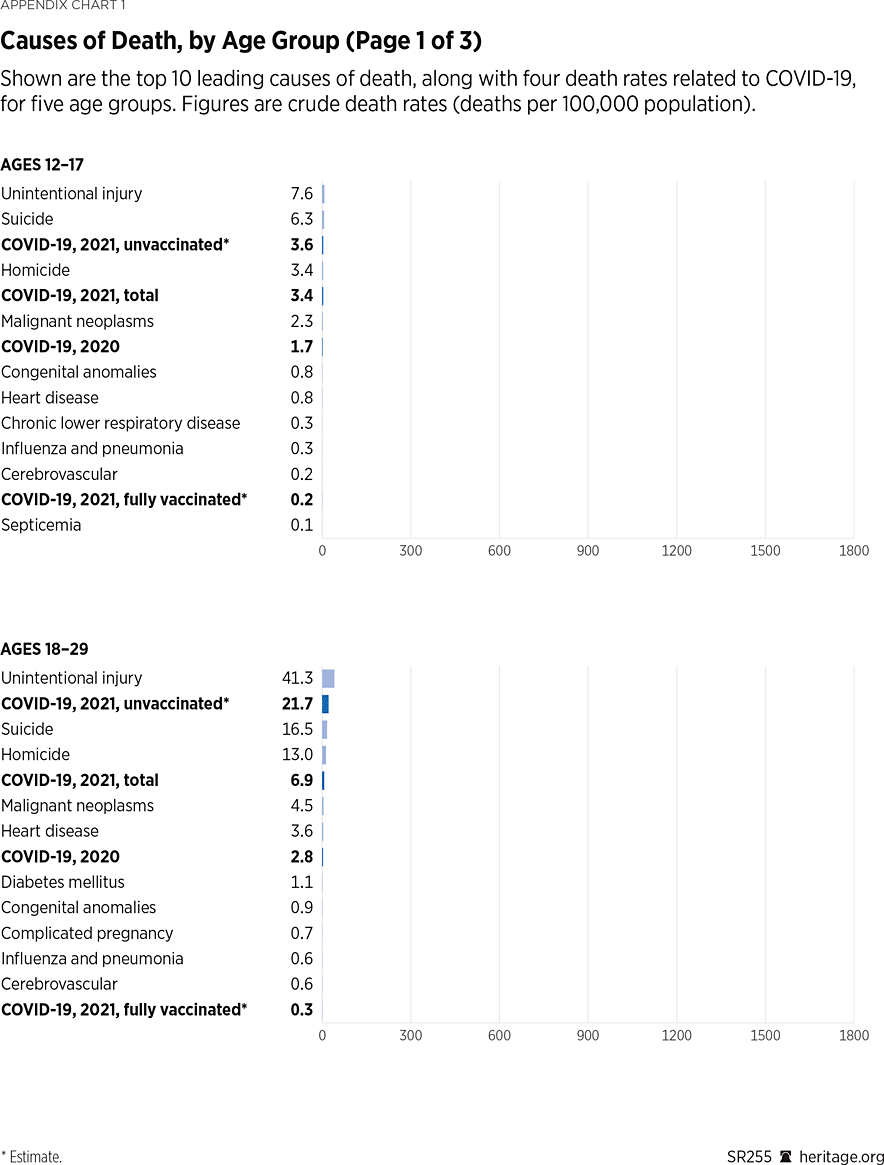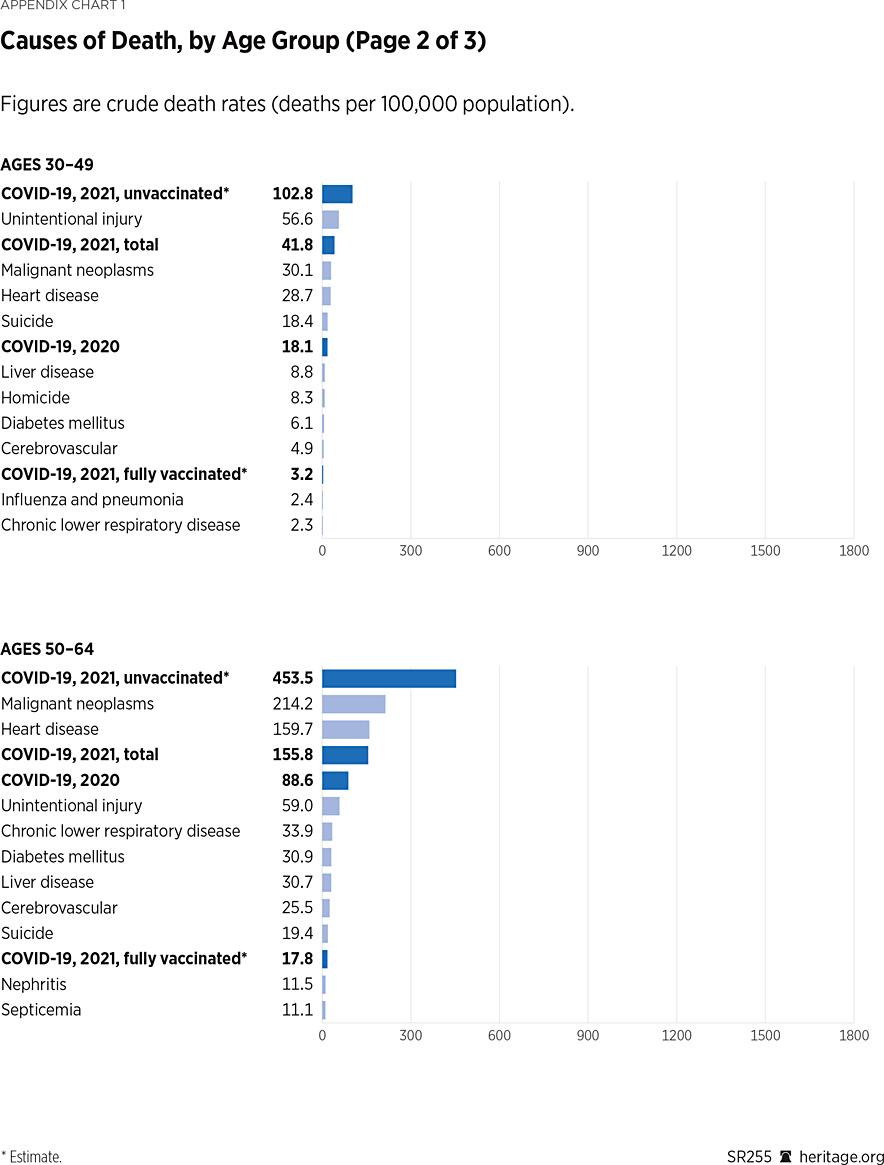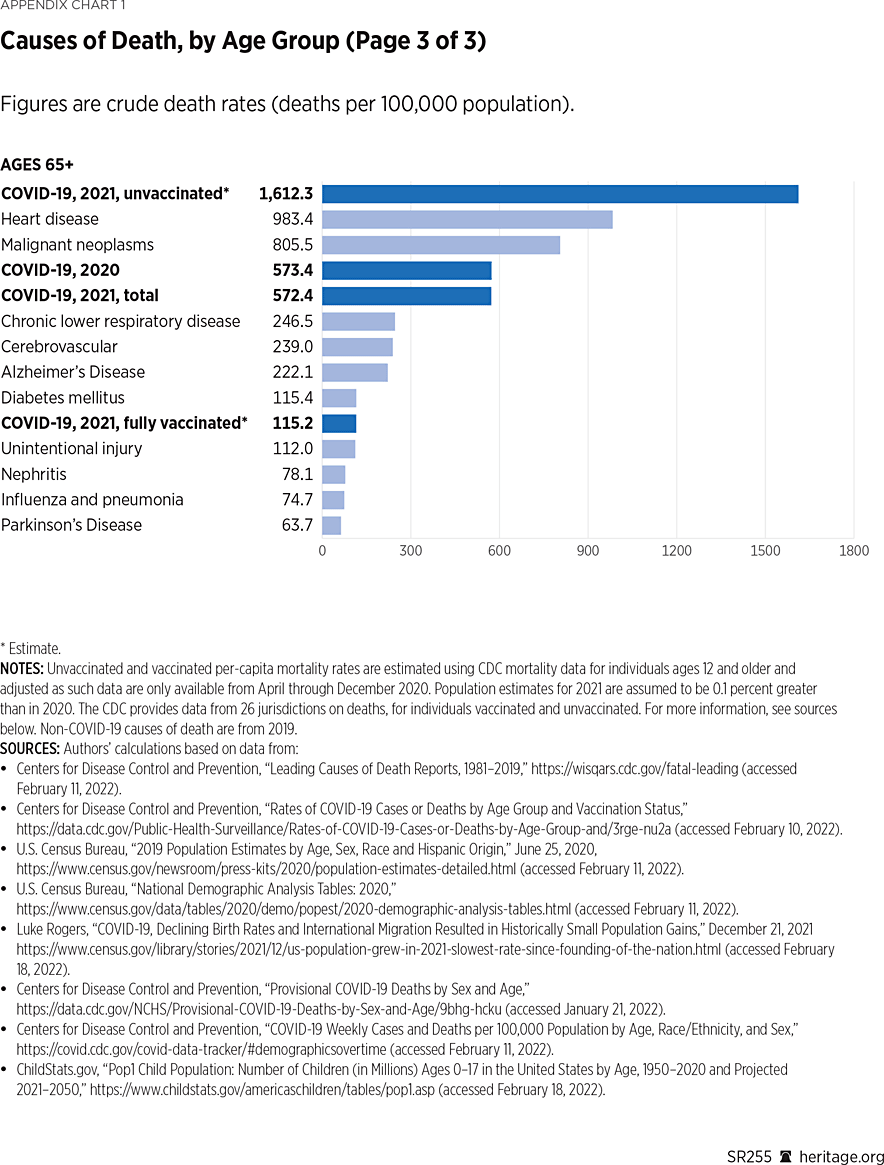Alex Azar, then-Secretary of Health and Human Services (HHS), declared a national public health emergency in response to COVID-19 on January 31, 2020.REF The declaration soon triggered a frenzy of government interventions in the social and economic lives of 330 million Americans. Those interventions aimed to mitigate or eradicate the SARS-CoV-2 virus.
More than two years into the pandemic, “zero-COVID” now appears to be an unrealistic goal. The last major virus to be truly eradicated was smallpox over 40 years ago—almost 200 years after the development of its vaccine in 1796.REF
This Special Report statistically examines how the pandemic, and our understanding of it, has evolved over time. Using data from a variety of sources—both foreign and domestic—we examine the efficacy of natural and vaccine-acquired immunity in reducing the risk of COVID-19-related hospitalizations and mortality. We also look at whether the data support the assertion that the United States is suffering a “pandemic of the unvaccinated.” Lastly, we assess how new data, along with the advent of innovative treatments, should reshape public policy toward COVID-19.
We conclude that policymakers should adapt their approach to ever-changing facts on the ground, including the increasing likelihood that the SARS-CoV-2 virus will remain in circulation indefinitely. In fact, the director of the Centers of Disease Control and Prevention (CDC), Rochelle Walenksy, noted that COVID-19 “is likely to become an endemic disease here in the United States and really around the world.”REF We will thus need to learn to live with the virus as we already do with many other problems such as heart disease, cancer, hepatitis, influenza, and HIV. Coexistence should replace eradication as the lodestar of pandemic policy.
More specifically, we suggest that policymakers eschew restrictions and mandates and instead restore pre-pandemic social and economic arrangements, understanding the usefulness of vaccinations, natural immunity, and anti-virals at being able to control the virus. Or, to put it more simply, it is time to return to our pre-pandemic understanding of “normal.”
What We Have Learned About the Pandemic
COVID-19 Cases and Hospitalizations Reached New Heights in January 2022 Despite Aggressive Pharmaceutical and Nonpharmaceutical Interventions. Newly confirmed cases of COVID-19, generally defined as the number of people who return positive tests, have continued to rise and fall throughout the first two years of the pandemic.
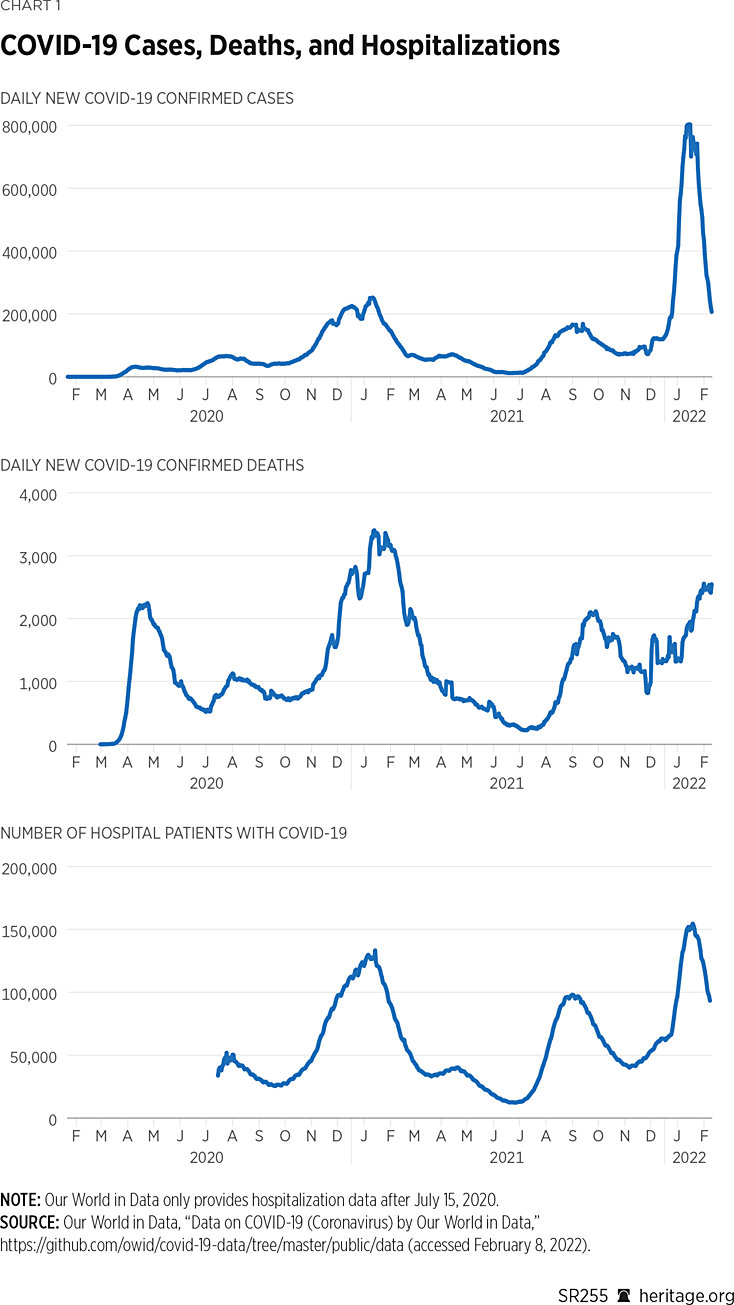
As Chart 1 illustrates, after the first confirmed COVID-19 case was reported in Washington State in January 2020, infections and deaths fluctuated over the coming months, subsequently reaching a peak in December 2020 and January 2021.REF After the wave of new infections crested, the United States experienced a steep decline. The Food and Drug Administration (FDA) granted emergency use authorizations (EUAs) to two mRNA vaccines in December 2020.REF The ebbing of cases and deaths occurred as tens of millions of people were being vaccinated, feeding the hope that immunizations would end the pandemic.
But during the summer of 2021, the Delta variant became dominant in the United States, leading to an increase in cases and hospitalizations, which subsided in September.
The Omicron variant, which became the dominant strain in December 2021, caused the biggest spike in cases since the pandemic’s onset. The new variant also caused a rise in deaths with COVID-19, although the peak number of daily deaths has remained far below the levels seen before widespread immunizations.
Hospitalizations, presented in Chart 1, traced an arc similar to the rise and fall in cases. Hospitalizations achieved three primary peaks: the winter of 2020–2021, the summer of 2021 during the Delta variant phase, and now most recently during the winter of 2021–2022 with the Omicron variant. Public health experts have cited disease proliferation as a primary justification for restrictive measures such as travel bans, mask mandates, and vaccine mandates.REF
It Is Not a Pandemic of the Unvaccinated. Since mass immunizations were believed to augur the pandemic’s end, some public officials attributed the surges in cases and hospitalizations during the summer of 2021 and the subsequent winter to the unvaccinated. This allegation took on highly political tones in the United States, where vaccine resistance was more common in red states than in blue ones. President Biden, for example, attributed a recent increase in hospitalizations to a “pandemic of the unvaccinated.”REF
“The unvaccinated are taking up hospital beds and crowding emergency rooms and intensive care units,” he said on January 4, 2022. “That’s a place that other people will need access to those hospitals.”REF
It is impossible to verify these claims using HHS data. These data do not identify whether a patient hospitalized with COVID-19 was admitted because of COVID-19, nor do they differentiate between vaccinated and unvaccinated patients.REF
Data sources compiled by states as well as the United Kingdom, however, suggest the President’s assertions are untrue. For example, Chart 2 presents data from New York State, which distinguish between patients admitted because of COVID-19 and those admitted for other reasons but who also tested positive for COVID-19.
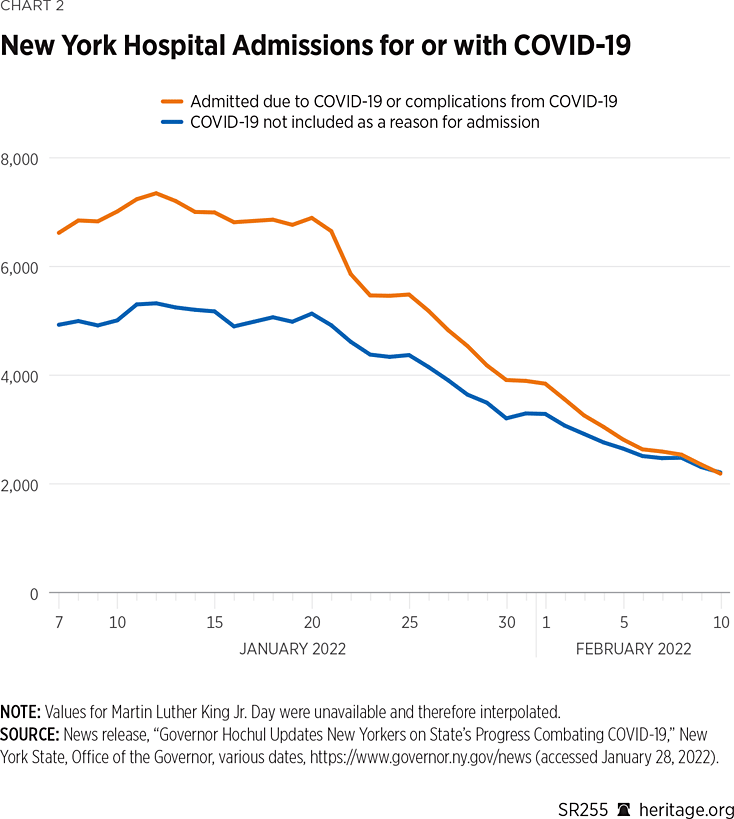
As Chart 2 demonstrates, New York has consistently had between 4,000 and 13,000 patients testing positive for COVID-19. However, roughly 40 percent of these patients entered the hospital for reasons other than a COVID-19 diagnosis. They were hospitalized with the infection, not because of it. U.S. government data that count beds that are “in use” by patients with COVID-19 without making these distinctions thus overstate the impact of the disease itself on hospital resources.REF
It is also difficult to find comprehensive data that sort hospitalized COVID-19 patients by vaccination status. Although the CDC does provide some data via its COVID-net system, these data are based on a self-selected sample of hospitals and are thus not comprehensive. There are, however, some data on the issue from the Commonwealth of Massachusetts and the United Kingdom on the vaccination status of patients admitted with COVID-19.
The Commonwealth of Massachusetts. Massachusetts provides breakdowns of raw hospitalization numbers across all counties by vaccination status, presented in Chart 3.REF As is apparent in Chart 3, the number of fully vaccinated patients hospitalized with COVID-19 is indeed non-trivial and has picked up significantly during the Omicron surge. Chart 3 presents the percentage of patients hospitalized for COVID-19 who are fully vaccinated.
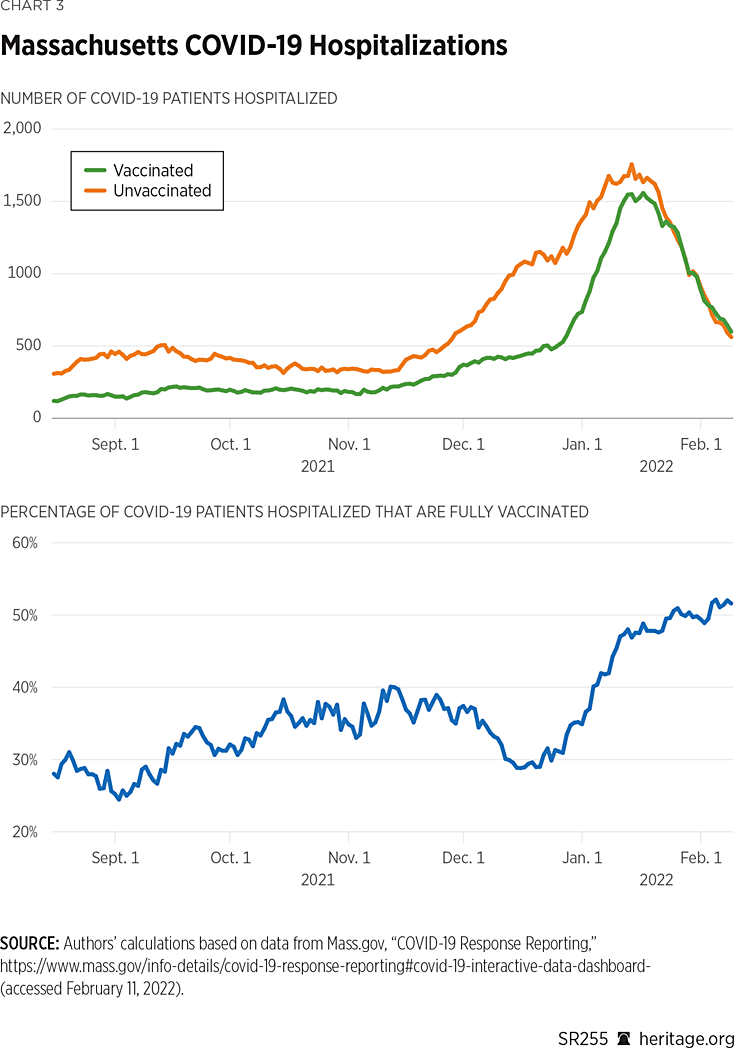
As of mid-January, nearly half the patients hospitalized with COVID-19 in Massachusetts were fully vaccinated or boosted.REF Like New York State, Massachusetts also reports data that differentiate between hospitalizations with COVID-19 from hospitalizations caused by COVID-19. These data are presented in Chart 4.
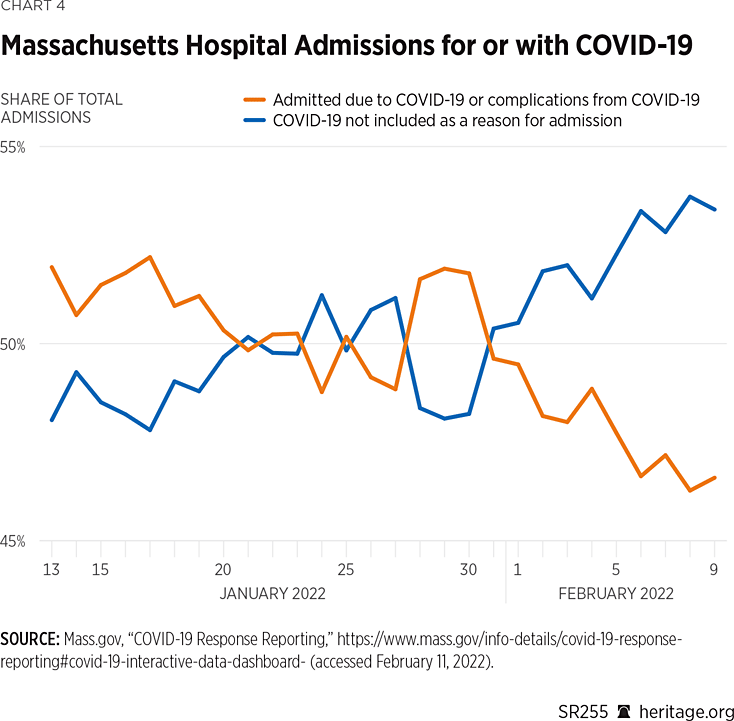
As Chart 4 illustrates, since January 13, 2022, there has been a roughly 50/50 split amongst hospitalizations for and with COVID-19. In mid-January 2022, around 52 percent of inpatients who tested positive for COVID-19 were admitted for that reason or to treat complications of the disease. This percentage declined throughout the month of January, with incidental hospitalizations with COVID-19 surpassing hospitalizations for the virus in February.
The United Kingdom. Data from other countries can also shed light on the effect of vaccines on hospitalization and death, especially since the CDC fails to compile sufficiently comprehensive data on the issue. The U.K. government keeps data on the vaccination status of patients admitted due to COVID-19 after having presented themselves for emergency care.REF Table 1 shows the U.K. data for the four weeks between January 16 and February 6, 2022, during which Omicron was the dominant variant.REF
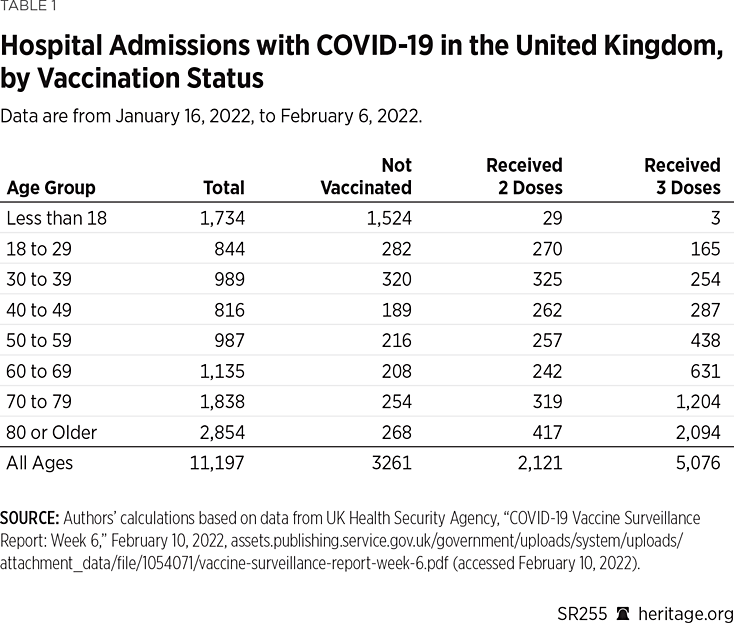
Of the 11,197 patients who visited emergency rooms in the U.K. and were subsequently admitted for COVID-19 over this period, 739 either had an unknown vaccine status or had received only their first dose. Unvaccinated patients accounted for 3,261 admissions (29 percent of the total number of COVID-19 admissions), while fully vaccinated or boosted patients accounted for 7,197 admissions (64 percent of COVID-19 patients).
In every adult age cohort, the number of vaccinated patients hospitalized for COVID-19 exceeded the number of hospitalized unvaccinated patients. In older patients—those ages 60 and above—the number of boosted COVID-19 patients outnumbered unvaccinated COVID-19 patients.
The President’s assertion that the unvaccinated are overcrowding hospitals and denying care to other seriously ill patients is thus unsupported by the data we have examined. The Massachusetts and U.K. data suggest that among hospital patients admitted for COVID-19, there is indeed a substantial number (nearly 50 percent to over 60 percent) that are vaccinated.
Vaccines Reduce the Risk of Hospitalization and Death from COVID-19. Although many, if not most, patients hospitalized with COVID-19 are vaccinated, that does not mean vaccines do not work. The reason: a smaller percentage of vaccinated people than of unvaccinated people enter hospitals. The risk that a vaccinated person enters a hospital due to COVID-19 is thus lower than the risk to an unvaccinated person, even if the number of vaccinated hospitalizations exceeds the number of unvaccinated hospitalizations. Analysis from both Massachusetts and the U.K. document this interesting finding that is perhaps counterintuitive to some.
Massachusetts Data. Chart 5 shows the percentage of vaccinated and unvaccinated Massachusetts residents who entered hospitals with COVID-19 between August 16, 2021, and February 9, 2022.
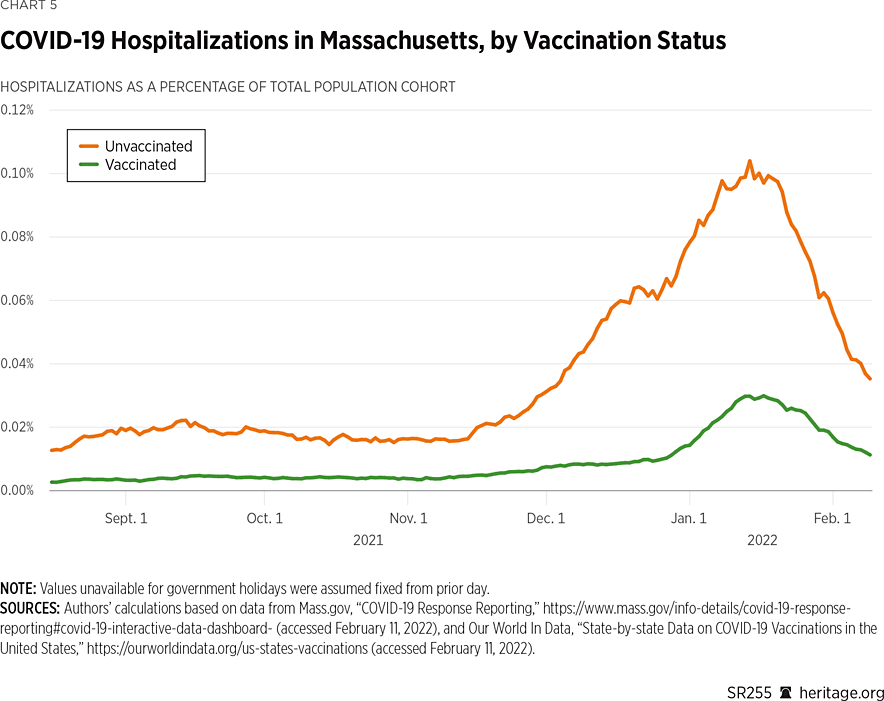
As Chart 5 illustrates, both groups have incurred increases in hospitalizations for COVID-19 over the past few months despite also having relatively low percentages (less than 0.15 percent) of their respective cohorts hospitalized for COVID-19. Nevertheless, Chart 5 demonstrates that the fully vaccinated comprise a significantly lower percentage than their unvaccinated counterparts, suggesting that they are, as a group, less likely to be hospitalized for COVID-19.
There are two limitations to this inference. First, Massachusetts does not group patients by age. Second, the data do not match vaccinated and unvaccinated patients for comorbidities. Those same limitations, of course, also apply to the raw counts of hospitalizations. Without such data it is difficult to comprehensively ascertain the effect of vaccinations at preventing hospitalization, which is worthy of future research. Nevertheless, based on our analysis using data that are available, it does appear that the overall hospitalization rate in Massachusetts is indeed lower among the vaccinated than the unvaccinated.
U.K. Data. Unlike the data from Massachusetts, data from the U.K. do indeed group patients hospitalized with COVID-19 by age as well as vaccination status. Table 1 above showed that roughly twice as many vaccinated patients as unvaccinated patients were hospitalized for COVID-19 between January 16 and February 6, 2022.
Chart 6 shows that, for most age brackets, the percentage of vaccinated people hospitalized for COVID-19 was smaller than that of unvaccinated people hospitalized for the disease.
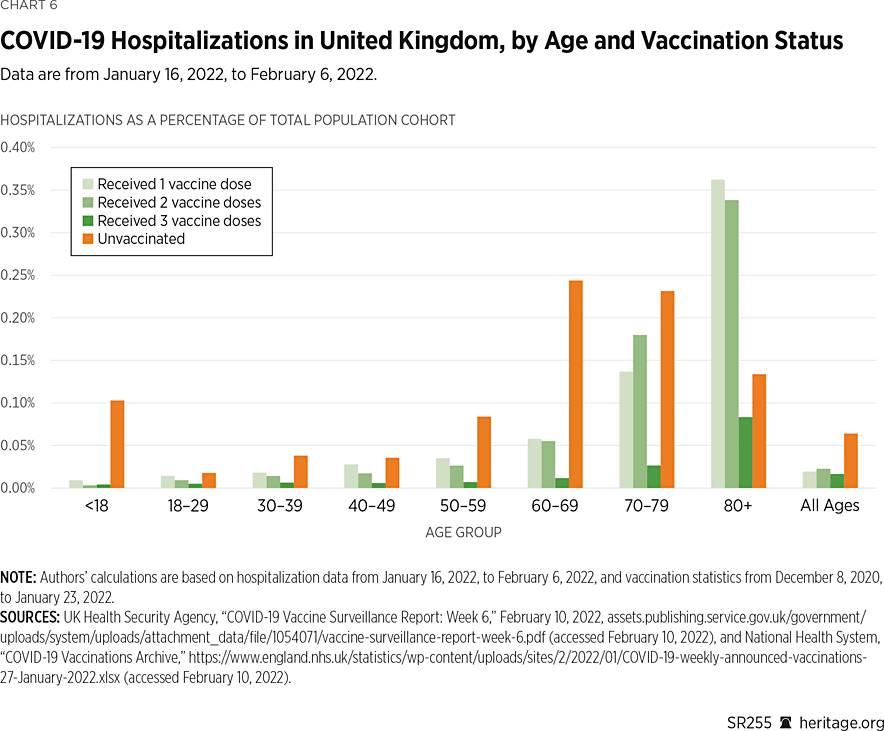
For all ages, approximately 0.06 percent of unvaccinated people entered hospitals because of COVID-19. This percentage is more than three times that of people who have received one, two, or three doses (0.02 percent). Across all ages, the percentage of people hospitalized is lower for those who received three doses than for the unvaccinated, suggesting that those boosted against COVID-19 have the lowest risk of hospitalization.
All age groups under 80 have lower percentages of hospitalizations among those with one, two, or three shots than their unvaccinated counterparts. Hospitalization rates for those in their 80s and older are higher among people who have had one or two doses than among the unvaccinated, but those in that age group who have been boosted have the lowest rates of all. Regardless, all percentages are under 1 percent of each cohort’s population.
The U.K. data on COVID-19-related mortality exhibit a similar pattern. Chart 7 shows the number of deaths during the four weeks between January 16 and February 6, 2022, by age and vaccination status.
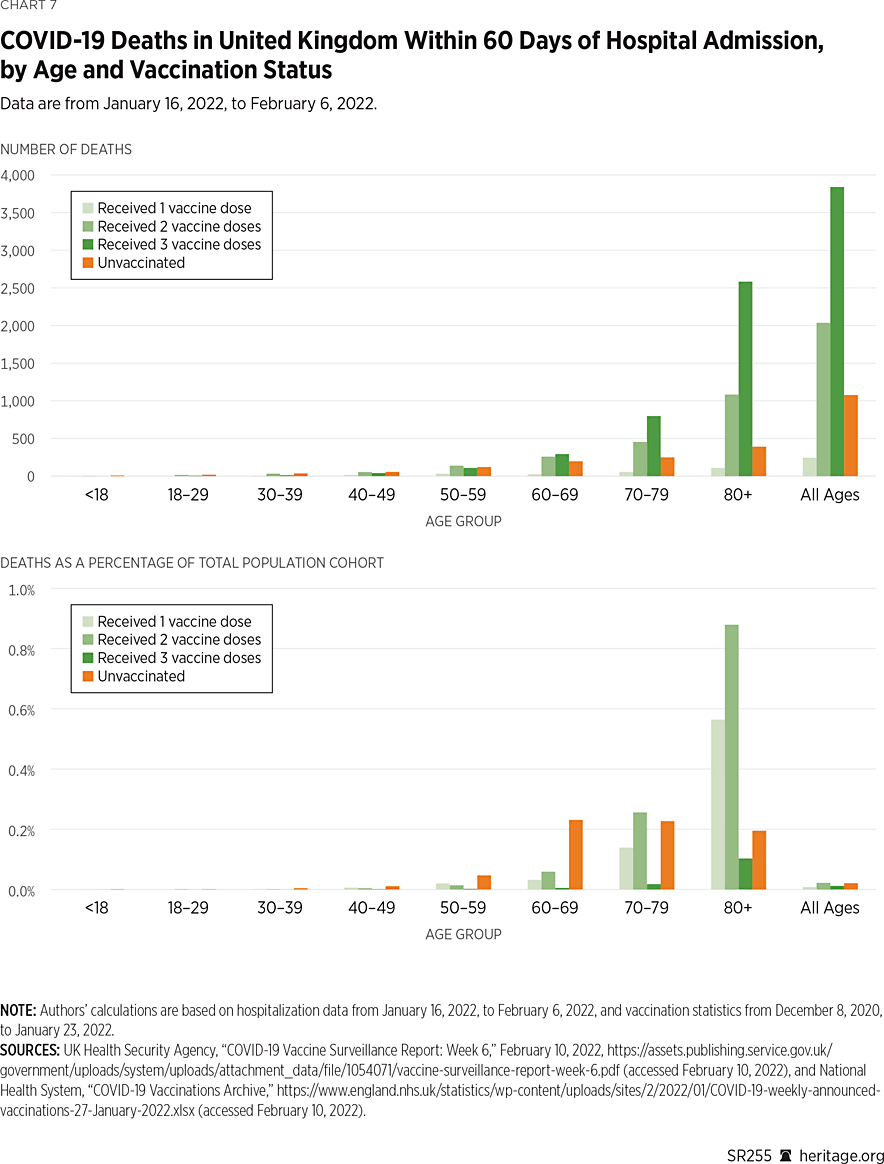
As expected, deaths are most numerous at the oldest age groups, rare among those under 30, and low among those ages 30–50. What is striking is the large number of deaths among the vaccinated and boosted compared with the unvaccinated. Those who have completed their vaccination courses account for the largest number of deaths, followed by those who have been boosted. Together, more than twice as many deaths occurred among these two groups as among unvaccinated people.
These numbers do not establish that vaccinated and boosted people are more likely to die from COVID-19 than are the unvaccinated. Chart 7 shows the percentage of COVID-19 deaths with 60 days of admission by age and vaccination status.
Chart 7 shows that the overall risk of dying from COVID-19 is minuscule for people younger than 50, regardless of vaccination status (<0.01 percent for all such groups having any level of vaccination and 0.01 percent for the 40–49 unvaccinated age group). For those in their 50s and 60s, the risk is most significant for the unvaccinated. That changes for those ages 70 and older. In the two oldest age brackets, the mortality risk is highest for those who have gotten two vaccine doses and lowest for those with three doses. While assessing the value of boosters is beyond the scope of this paper, this analysis appears to suggest that among the cohorts at greatest risk of COVID-19 mortality, boosters may offer the greatest level of protection.REF
This assessment is subject to limitations since, as with raw counts of the number of deaths by vaccination status, unvaccinated and vaccinated people were not matched by gender, comorbidities, natural immunity acquired from prior infection, and other potentially relevant factors. Adjusting for these factors would be a more comprehensive way to assess the efficacy of vaccines. Acquiring and analyzing such data are areas worthy of future research.
Altogether, however, our analysis of data from Massachusetts and the U.K. demonstrates that a significant number of people hospitalized because of COVID-19 are vaccinated and that most COVID-19 deaths that have occurred during the Omicron wave in the U.K. occurred among people who have been vaccinated or boosted. However, our analysis based on percentage computations across age groups also suggests that risk of hospitalization and death is lower for the vaccinated than for the unvaccinated for most age groupings.
Natural Immunity Reduces the Risk of Infection and Hospitalization. Since the pandemic began, research has suggested that natural immunity can be quite robust at preventing subsequent infection.REF The CDC, however, did not release meaningful data on natural immunity until January 2022.REF The study examines the impact of vaccination and prior COVID-19 infection against subsequent infections and hospitalizations between May and November 2021 across California and New York, which, the authors note, account for 18 percent of the U.S. population. It considered four cohorts of adults (over 18):
- Those who were unvaccinated with no prior laboratory-confirmed COVID-19 diagnosis;
- Those vaccinated (14 days after completion of a primary COVID-19 vaccination series) with no prior COVID-19 diagnosis;
- Those unvaccinated with a prior COVID-19 diagnosis; and
- Those vaccinated and with a prior COVID-19 diagnosis.
The authors compared these four groups in terms of incidence of confirmed COVID-19 cases and hospitalizations for California while only providing case incidence comparisons for New York (citing unavailable hospitalization data). Their results for California are presented in Chart 8.
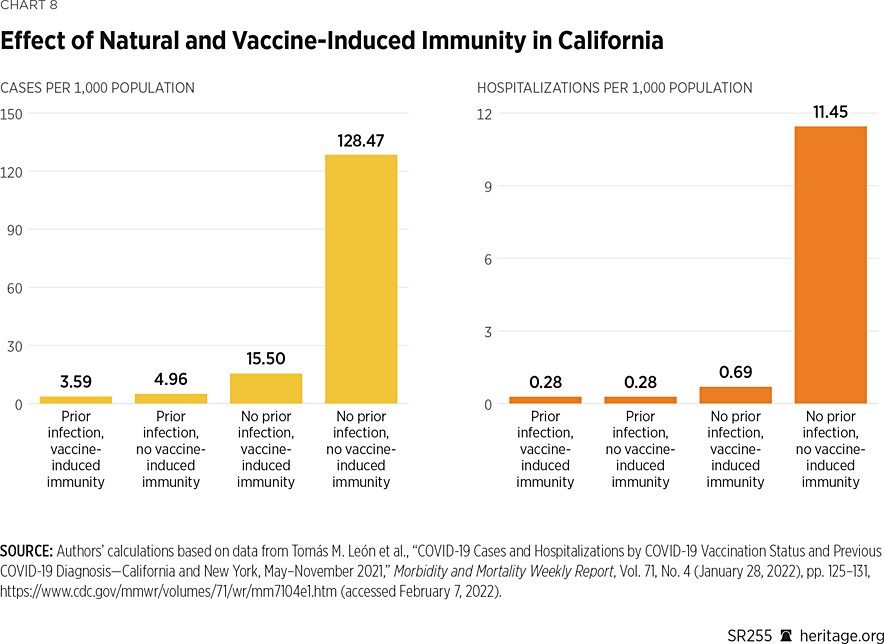
As Chart 8 shows, the CDC study suggests that natural immunity is even more effective at preventing case incidence and hospitalization than vaccine-induced immunity is. Those who have both recovered from infection and been vaccinated appear slightly more protected. According to the study, there does not appear to be any meaningful positive effect of natural immunity coupled with vaccine-induced immunity on the incidence of hospitalization.
As the CDC study does not examine mortality, it is not possible to determine whether the same pattern holds for deaths as for infections and hospitalizations. Regardless, the CDC data indicate that natural immunity indeed provides robust protection against subsequent infection and hospitalization.REF
Recent research published in the Journal of the American Medical Association found that breakthrough infections of the Delta variant created a robust immune reaction in response to the Delta variant. Although little work has yet been done on the Omicron variant, the authors suggest that the immune response may very well be highly efficacious against other variants as well, suggesting—though not establishing—that the Omicron variant could induce super-immunity against the virus.REF
While hospitalization and per capita death rates of COVID-19 were the primary reasons for initial government nonpharmaceutical interventions, statistics now indicate that natural and vaccine-induced immunity provides overwhelming protection against COVID-19.
COVID-Related Mortality Is Highly Age-Stratified Regardless of Vaccination Status. COVID-19 has impacted various age groups in society in different ways. As Chart 9 illustrates, more than 85 percent of confirmed cases are among people under 65, while more than 75 percent of COVID-19-related deaths are among people aged 65 and older.
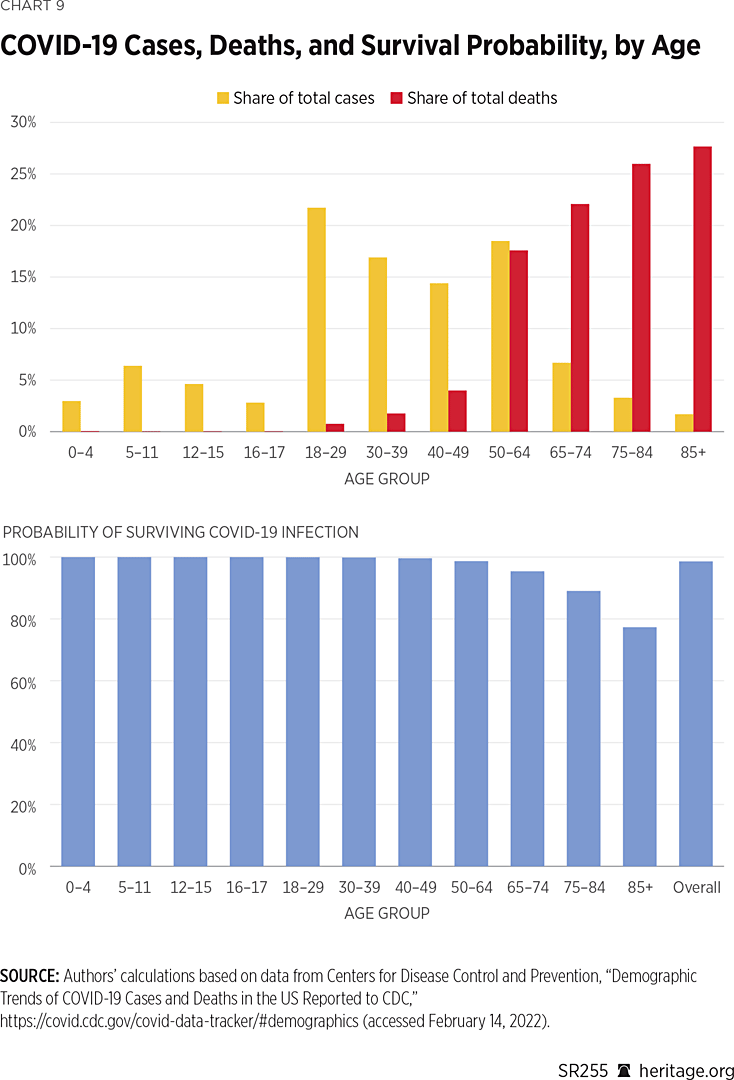
Chart 9 lays out the probability of surviving a confirmed case of COVID-19 by age group. As Chart 9 demonstrates, the overall probability of surviving COVID-19 is over 98 percent. Those under 50 have better than a 99.5 percent chance of recovery. These probabilities drop quickly for older age groups, but still, those between the ages of 65 and 74 have a 95.4 percent survival rate, and those ages 85 and older have a 77.3 percent survival rate.
It is helpful to put the mortality of COVID-19 in perspective with other causes of death. We do so for COVID-19 in 2020 and 2021 and other causes of the first year before the pandemic in 2019, by presenting crude death rates in Chart 10.
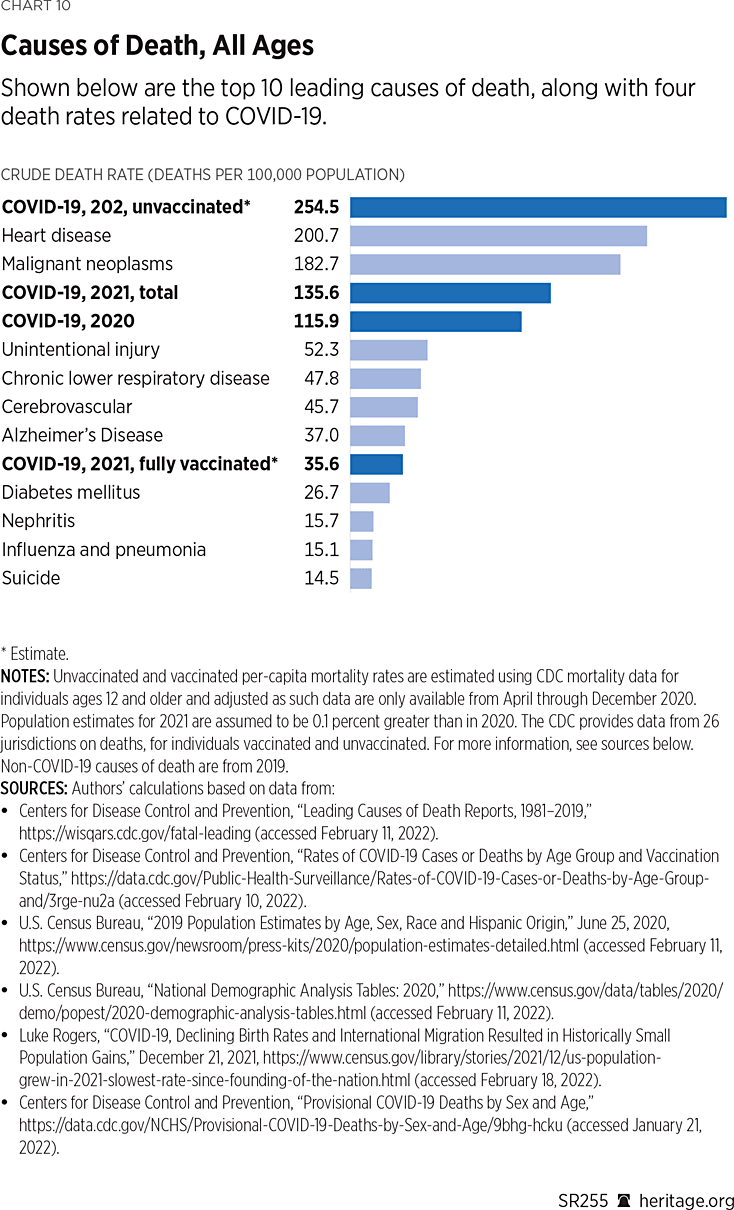
Across all age groups, heart disease was the leading cause of death in the country in 2019, followed by cancer. COVID-19 was the next leading cause of death in 2020 and 2021 (115.9 and 135.6 per capita, respectively). The fully vaccinated, however, had a significantly lower per capita death rate (35.6), similar to other causes of death, including diabetes (26.7), influenza (15.1), nephritis (15.7), and suicide (14.5).
We also present a number of similar calculations in Appendix Chart 1, broken down by age. These statistics suggest that, for all groups under 65, the fully vaccinated are protected against COVID-19 as the virus carries a significantly lower per capita death rate than most if not all other causes of death across the respective age groups. Given the analysis presented in the prior section, this finding may also be true for the naturally immune.
The group 65 and above, not surprisingly, has the highest per capita death rates for a variety of illnesses, with cancer, heart disease, chronic lower respiratory diseases, and cerebrovascular illnesses leading the list prior to the pandemic. The per capita death rates for COVID-19 in both 2020 and 2021 (573.4 and 572.4, respectively), however, exceed a number of leading causes prior to the pandemic, demonstrating that COVID-19 has been a particularly dangerous potential cause of death for people above the age of 65. In fact, for the unvaccinated, the estimated per capita death rate (1612.3) exceeds all other causes of mortality. Fortunately, for the vaccinated this rate is significantly lower (115.2), below Alzheimer’s and diabetes mellitus. Thankfully, as Appendix Chart 1 illustrates, those in this age cohort who contract COVID-19 have between a 77 percent and 95 percent chance of survival depending on their age. Additionally, although the per capita death rate for the fully vaccinated (115.2 per capita) is indeed higher for the above-65 age group than their younger counterparts, on a percentage basis, this rate translates to 0.12 percent of the age cohort’s population.
Unvaccinated People Are Unlikely to Change Their Minds. Our analysis indicates that although natural immunity from COVID-19 does seem to provide strong protection, there are benefits of vaccination at averting serious illness from COVID-19. And while the chances of surviving infection are high for most age groups, vaccinated people have a much lower COVID-19-related mortality rate than do the unvaccinated.
Chart 11 represents the evolution of the number of people fully vaccinated against COVID-19 over time. After the FDA granted EUAs for two vaccines in December 2020 and the pace of production, distribution, and administration quickened, the rate of daily new vaccinations grew rapidly, peaking in the spring of 2021.
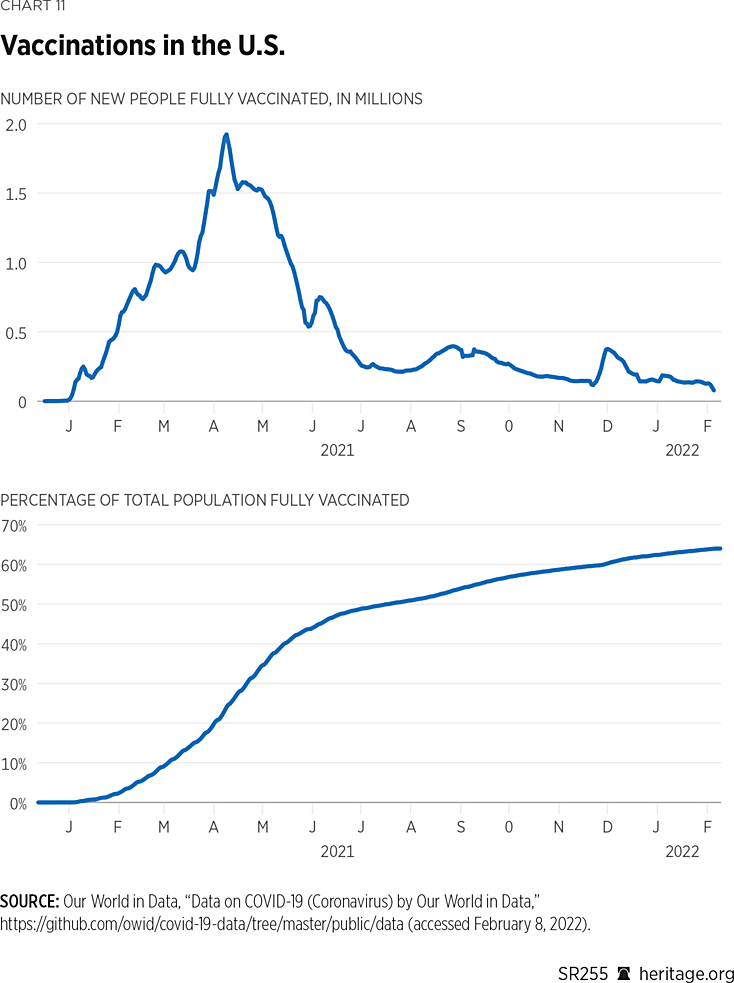
Afterward, uptake gradually declined, despite ample supply, with slight upticks before the fall and winter 2021 seasons. The American Academy of Family Medicine noted that primary reasons for vaccine hesitancy included a preference for natural immunity, concerns about safety and efficacy, distrust of government and health organizations, and desire for autonomy and personal freedom.REF As of February 22, 2022, 65 percent of the American population has been fully vaccinated against COVID-19.">REF
After vaccination rates slowed during the summer of 2021, even as the number of confirmed cases spiked, President Biden reversed his opposition to federal vaccine mandates.REF His executive orders directed various federal agencies to impose COVID-19 vaccine mandates on federal workers and contractors, hospitals and other health care facilities, and private firms with at least 100 employees.REF
These mandates faced court challenges. The U.S. Supreme Court struck down an emergency temporary standard issued by the Occupational Safety and Health Administration that placed a mandate on private companies, but it upheld an interim final rule by the Centers for Medicare and Medicaid Services mandating that health facilities require their workers to be immunized.REF
Many companies continue to impose vaccine mandates on their workers. Some states prohibit such mandates by private employers. Others permit them but require employers to grant exemptions.REF Some states require public workers to be vaccinated, while others prohibit counties and cities from establishing and enforcing such mandates on their employees.REF
This patchwork of mandate policies had an uncertain effect on vaccination rates, which in January 2022 fell to the lowest levels since January 2021, when vaccines were still in short supply.REF
All of this suggests that attitudes among the unvaccinated have hardened. In September 2021, the Cato Institute commissioned YouGov to survey attitudes toward the vaccine and if specific incentives could change the minds of the vaccine-hesitant.REF We present some of the results in the study in Chart 12.
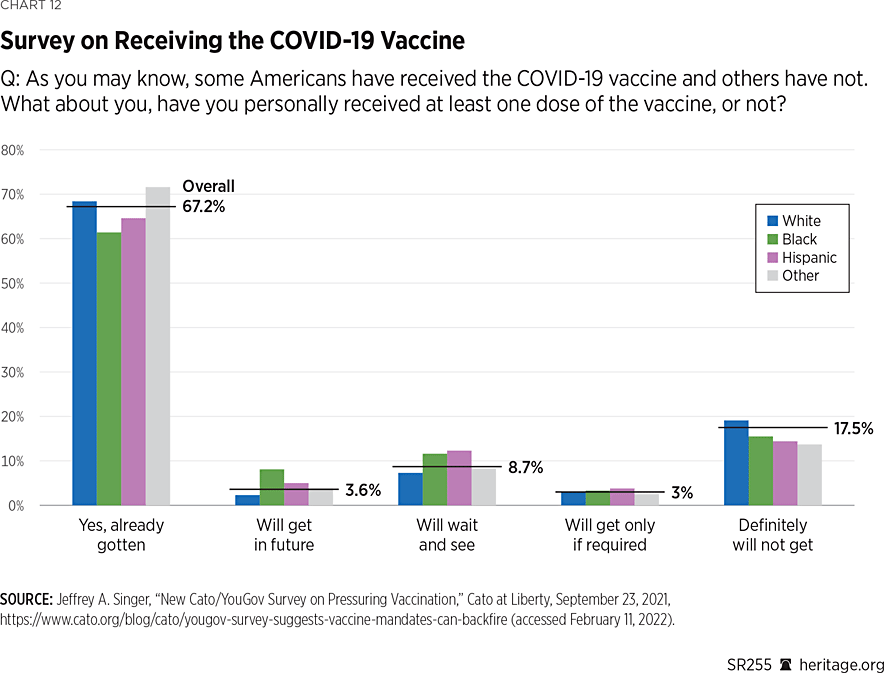
As this chart demonstrates, although most Americans have been vaccinated, and others say they are willing to take the vaccine, a high percentage (17.5 percent) is completely unwilling to do so. As presented in Chart 12, resistance varies by race but is nevertheless non-trivial across all races. Vaccine resistance remains strongest among young adults. Through February 22, 2022, over 23 percent of adults ages 18–24 and over 21 percent of those ages 25–39 had not received a single dose of the vaccine.REF
As the data compiled in Chart 12 illustrate, many unimmunized adults will not change their minds about the vaccine. The public health effects of their resistance to vaccines are mitigated to some extent by the fact that many unvaccinated people likely have natural immunity.
Promising New Treatments Can Vastly Reduce the Risk of Hospitalization and Death Among Those with COVID-19. In December 2020, the FDA granted EUAs for two vaccine products, both of which have reduced the risks of severe illness and death from COVID-19. In December 2021, the FDA granted EUAs for two anti-viral products: Molnupiravir (produced by Merck) and Paxlovid (made by Pfizer).REF Both are oral medications.
Randomized controlled trials for Molnupiravir found the drug to prevent 30 percent of symptomatic cases from progressing to severe disease.REF Paxlovid was 89 percent effective in preventing hospitalization, with no deaths reported in clinical trials.REF Both drugs were so effective that trials were interrupted because it would have been unethical to deny the medication to the placebo arms.REF
The Biden Administration has ordered 10 million courses of Paxlovid, making it widely available to prevent hospitalizations.REF One of the reasons some have continued to advocate for government protection measures for COVID-19 is because hospitalizations of COVID-19 still exceed those of common respiratory infections including influenza and respiratory syncytial virus (RSV). This comparison is discussed in a recent paper published in the Journal of the American Medical Association co-authored by former Obama White House adviser Ezekiel Emanuel, who now serves as a vice provost at the University of Pennsylvania Medical School:REF
The appropriate threshold should reflect peak weekly deaths, hospitalizations, and community prevalence of viral respiratory illnesses during high-severity years, such as 2017–2018. That year had approximately 41 million symptomatic cases of influenza, 710000 hospitalizations and 52000 deaths. In addition, the CDC estimates that each year RSV leads to more than 235000 hospitalizations and 15000 deaths in the US. This would translate into a risk threshold of approximately 35000 hospitalizations and 3000 deaths (<1 death/100 000 population) in the worst week.
Whether the stated metrics are indeed the proper thresholds to be using is up for debate. For example, a recent paper published in the European Heart Journal noted that sepsis and heart failure appeared to be the leading cause of hospitalizations in the United States in 2018.REF The authors note, however, that they do not have data to compare these rates against COVID-19 and that doing so is a valuable avenue of future research. Regardless, earlier in this paper in Chart 2 we did observe that over 40 percent of COVID-19 hospitalizations in New York State are not even due to COVID-19 itself, and thus the CDC almost surely overstates the impact of COVID-19 on the American hospital system.
Nevertheless, if Paxlovid indeed fulfills the promise of its clinical trials, then the drug could dramatically reduce the severity of illness and burdens on hospitals imposed by COVID-19 to considerably lower levels. As a result, we developed a model to estimate what monthly hospitalizations would look like under various assumptions of uptake of Paxlovid. We estimated that, from December 21, 2021, to January 21, 2022, the hospitalization rate of COVID-19 was approximately 3.5 percent of confirmed cases.REF Assuming 3.5 percent, 5 percent, and 7 percent hospitalization rates from new cases and that 60 percent of COVID-19 hospitalizations are indeed for COVID-19 (and not with COVID-19, as indicated by Chart 2), Chart 13 provides estimates of what the weekly hospitalization rate will be under a variety of scenarios of daily caseloads and people testing positive for COVID-19 taking Paxlovid.
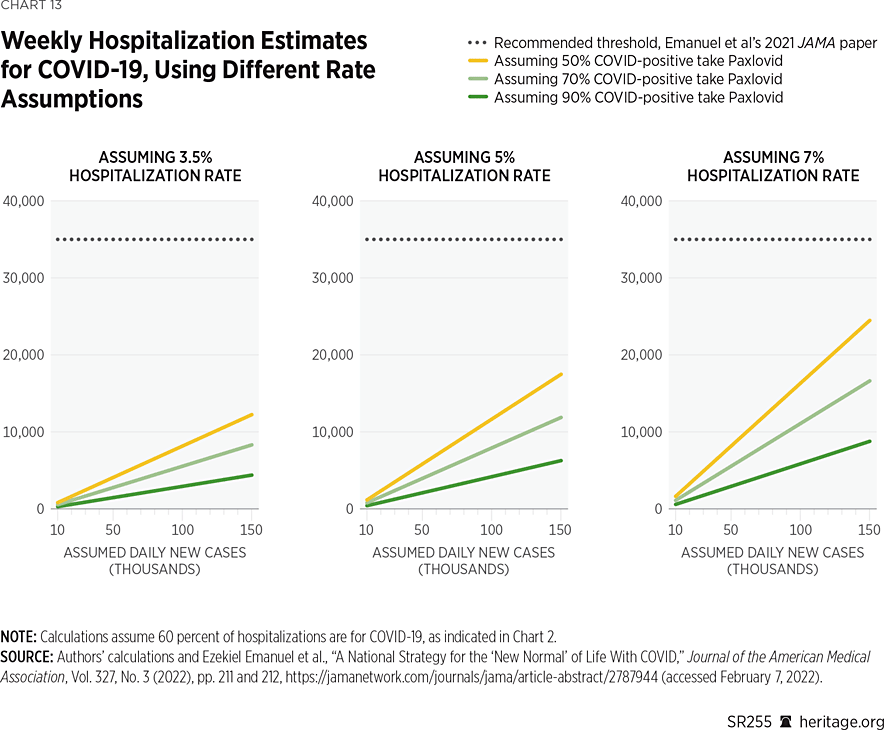
Note that under all such assumptions, weekly hospitalizations are below the stated threshold from 2017 to 2018 stated in Emanuel et al., even if COVID-19 were to mutate to a more dangerous form and current hospitalization rates of 3.5 percent were to double to 7 percent.REF
Although Paxlovid is not recommended for patients with specific conditions such as kidney or liver problems,REF our analysis in Chart 13 does not assume 100 percent uptake, and if other people testing positive for COVID-19 take other treatments such as Molnupiravir, these hospitalization numbers would decline further.
Altogether, as Chart 12 illustrates, many of the vaccine-hesitant are unlikely to change their minds. However, as Chart 13 shows, although the fully vaccinated are unlikely to get hospitalized for COVID-19, antivirals such as Paxlovid do offer alternatives—especially for the vaccine-hesitant—for avoiding unnecessary hospitalizations and getting the country well below influenza and RSV levels.
Policy Implications
Zero COVID Is an Unrealistic Aim. The public policy response to the pandemic in the United States and throughout the highly developed world has focused on nonpharmaceutical interventions and vaccines. Both policies appear to have reached the limits of their utility.
Federal public health authorities urged lockdowns, mask mandates, school closures, and related policies in hopes of slowing the spread of the contagion until a vaccine became available. When massive immunizations began during the winter of 2021, there was great optimism that they would end the pandemic. Cases, hospitalizations, and deaths were declining from what were then their highest peaks, just as tens of millions of Americans were getting immunized.
By early July, President Biden, who had campaigned promising to “shut down” the virus,REF proclaimed that the United States was “closer than ever to declaring our independence from a deadly virus.”REF But independence proved elusive, as cases reached a new high during the summer and vaccination rates stalled.
The Omicron variant produced the steepest spike in cases to date, prompting Dr. Anthony Fauci, chief medical adviser to the President, to acknowledge that, despite the vaccines, COVID-19 “will ultimately find just about everybody.”REF While vaccines continue to protect against severe illness, there is little hope they will eradicate the virus.
Public Policy Should Be Transparent, Open, and Broadly Acceptable to the Public. Policymakers should plainly and emphatically communicate that it is highly unlikely that the pathogen will be extinguished. It is far more likely that the virus will continue to circulate and that new variants will emerge, as has been the case with other respiratory diseases.
They should also shift from crisis communication mode, which depicts the risks of the virus in dire terms and without context. As Appendix Chart 1 shows, unintentional injuries, homicides, and suicides are more likely causes of death than COVID-19 among the fully vaccinated in many age groups. Additionally, data from New York State and Massachusetts on hospitalizations for and with COVID-19 suggest that hospitalization statistics presented by the agency may very well be inflated above actual levels.
The CDC should juxtapose hospitalization and mortality statistics for COVID-19 with analogous statistics for other common illnesses and causes of death and emphasize that risks are highly age-stratified. Statistics of this nature will enable the public to put COVID-19 in perspective with other public health problems we have faced as a nation, including obesity, HIV, and influenza, among others. Just as the CDC has a responsibility to inform Americans of public health dangers, the agency should also tell people when they are safe from severe illness and death from COVID-19.
End Nonpharmaceutical Interventions, Mandates, and Vax Shaming. Lockdowns, mask mandates, suspensions of in-person learning, and other nonpharmaceutical interventions were of dubious value. A meta-analysis of peer-reviewed studies of the value of lockdowns published by Johns Hopkins University concluded that while “lockdowns have had little to no public health effects, they have imposed enormous economic and social costs where they have been adopted.”REF A meta-analysis of the value of cloth masks published by the Cato Institute found “weak evidence” for facemask efficacy, adding that “ethical principles require that the strength of the evidence and the best estimates of amount of benefit be truthfully communicated to the public.”REF A study of the efficacy of extended school closures published by the British Royal Society concluded that “the lower susceptibility of school children substantially limited the effectiveness of school closure in reducing COVID-19 transmissibility.”REF A United Nations study noted that the costs of school closures “stand to be tremendous in terms of learning losses, health and well-being and drop-out.”REF
Nonpharmaceutical interventions, where aggressively pursued, thus had a questionable effect on public health and inflicted undeniable economic, social, and cognitive harm. Similarly, seeking to ostracize those who have refused immunizations—falsely proclaiming a “pandemic of the unvaccinated” and alleging without evidence that those who have declined vaccines are overcrowding hospitals—has not changed many minds. Nor has resorting to vaccine mandates, some of which were unlawful, driven up immunization rates.
Public officials should retreat from these policies and instead provide accurate information to support informed decision-making by private citizens.
Promote Effective Treatments. Anti-viral medications such as Paxlovid and Molnupiravir show considerable promise in preventing the progression of COVID-19 and averting hospitalizations and deaths. The Biden Administration’s decision to purchase 10 million courses of Paxlovid seems a sound one. Effective new treatments allow public officials to pivot away from apocalyptic pandemic narratives and instead urge people who suspect they have COVID-19 to seek testing and treatment. These treatments are a good alternative that the vaccine-hesitant could discuss with their doctors should they need them.
Recognize That We Will Need to Learn to Live with COVID-19 and Return to Normal. Public officials have bombarded Americans with negative information and false hopes for nearly two years. They have suggested that restrictions on businesses, churches, schools, and citizens would hold the contagion at bay until vaccines extinguished it. The gap between their rhetoric and reality has eroded public trust and deepened political and social divisions.
Policymakers can rebuild this trust by adapting their message to the evolving facts on the ground. The data we have presented suggest that the combination of vaccines, natural immunity, and new treatments have helped pave the way for a more measured and balanced policy response to the pandemic.
Leading U.S. figures and some foreign governments have begun to move in this direction, removing or relaxing mandates and restrictions and advocating policies based on coexisting with the pathogen rather than imagining its eradication.
As Ezekiel Emanuel notes in his Journal of the American Medical Association paper referenced earlier:REF
COVID-19 is here to stay. As the U.S. moves from crisis to control, this national strategy needs to be updated. Policymakers need to specify the goals and strategies for the “new normal” of life with COVID-19 and communicate them clearly to the public.
The authors agree with us acknowledging that eliminating COVID-19 is impractical:
The goal for the “new normal” with COVID-19 does not include eradication or elimination, e.g., the “zero COVID” strategy. Neither COVID-19 vaccination nor infection appear to confer lifelong immunity.
They instead call for learning to live with the virus. That includes understanding the SARS-CoV-2 virus as one of several respiratory viruses in circulation, including influenza and RSV.
On February 1, Denmark became the first European Union country to lift virtually all COVID-19 restrictions.REF The government rescinded mask mandates, no longer requires the use of vaccine passports, has allowed nightclubs to reopen, lifted limits on indoor gatherings, and ended social distancing. The announcement came after daily confirmed cases rose to 7,900 per million on January 29, more than triple the U.S. peak of 2,411 infections per million on January 15.REF The government cited high vaccination rates for its decision.
The United States has a lower vaccination rate but also has a lower case rate, millions of treatment courses on order, and an overwhelming majority of citizens favoring the course the Danish government has set. A Monmouth College poll released in January 2022 found that 70 percent of Americans agree that “it’s time we accept that COVID is here to stay and we just need to get on with our lives.”REF
That sentiment is shared by Americans who have experienced the pandemic in vastly different ways, including 78 percent of those who say they have had COVID-19 and 65 percent of those who say they have not. Men (73 percent) and women (68 percent) agreed with the statement, as did college graduates (63 percent) and those with no degree (74 percent), voters in red states (71 percent) and blue (70 percent), white non-Hispanics (71 percent) and racial minorities (69 percent), young adults (69 percent), the middle-aged (68 percent), and those ages 55 and older (73 percent). There is a partisan divide, with 89 percent of Republicans and 71 percent of independents but only 47 percent of Democrats agreeing with the statement.
A sea change in pandemic policy, in addition to being consistent with our evolving understanding of the contagion, would likely be well received by the public.
Conclusion
The national public health emergency is now in its third year. The pandemic has been the obsessive focus of public policy throughout that time. Perpetuating the national emergency mindset is futile, misguided, and infeasible, especially given what the data indicate as well as massive shifts in public opinion.
Public officials should communicate clearly that COVID-19 is one of many public health problems and diseases in circulation, that vaccines and natural immunity reduce the risk of severe illness and death, and that new medicines make COVID-19 a treatable disease. People at greatest risk of illness should still take precautions, but government mandates and restrictions are no longer appropriate.
It is time for policymakers to restore normality and move on from COVID-19.
Kevin Dayaratna is Principal Statistician, Data Scientist, and Research Fellow in the Center for Data Analysis, of the Institute for Economic Freedom, at The Heritage Foundation. Doug Badger is Senior Fellow in Domestic Policy Studies, of the Institute for Family, Community, and Opportunity, at The Heritage Foundation.
